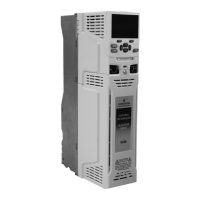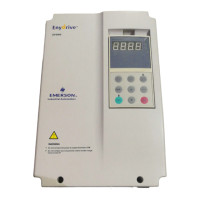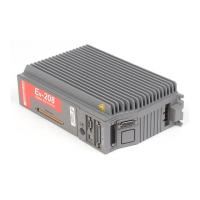Safety
information
Product
information
Mechanical
installation
Electrical
installation
Getting
started
User Menu A Commissioning
Advanced
Parameters
Diagnostics Optimization CT MODBUS RTU Technical Data
E300 Design Guide 201
Issue Number: 1
A test is only carried out when sensorless mode is not active. Position Feedback Phase Angle (C13) is updated by the test, but is not save in non-
volatile memory in the drive.
Most motors have a positive saturation characteristic so that increasing the current in the flux axis increases motor saturation. It is possible with some
motor designs for the characteristic to be reversed. If this is the case the phase angle measurement on enable will produce a value that is 180 deg
from the real value.
See Motor Rated Frequency (B06).
The following describes how an auto-tune test can be initiated and normal operation can be resumed after the test for Open-loop mode:
1. An auto-tune test cannot be initiated if the drive is tripped or the drive inverter is active, i.e. Drive OK (L05) = 0 or Drive Active (L06) = 1. The
inverter can be made inactive by ensuring that the Final drive enable is inactive, or the Final drive run is inactive.
2. An auto-tune test is initiated by setting Motor Autotune (B11) to a non-zero value and making the Final drive enable and the Final drive run active.
3. All tests that move the motor will move the motor in the forward direction if Direction Input 2 CW (G40) = 1 and Direction Input Invert (H12) = 0, or
the reverse direction if Direction Input 1 CCW (G39) = 1 Direction Input Invert (H12) = 0.
4. If the auto-tune sequence is completed successfully the Final drive enable is set to the inactive state and Motor Autotune (B11) is set to zero. The
Final drive enable can only be set to the active state again by removing the enable and re-applying it.
5. If a trip occurs during the auto-tune sequence the drive will go into the trip state and Motor Autotune (B11) is set to zero. As in 4. above the enable
must be removed and re-applied before the drive can be restarted after the trip has been reset. However, care should be taken because if the
auto-tune was not completed the drive parameters that should have been measured and set up will still have their original values.
The following describes the effects of the auto-tune test on the drive parameters for Open-loop mode:
1. All auto-tune tests rely on the motor being stationary when the test is initiated to give accurate results.
2. The parameters associated with the motor map are updated as a result of the test.
3. When each stage of the test is complete the results written to the appropriate parameters and these parameters saved in the drive non-volatile
memory. If Parameter Cloning (N01) is set to 3 or 4 the parameters are also written to a non-volatile media card fitted in the drive.
Action On
Enable (B09)
Action
Disabled (0) No phasing test is carried out on enable
Short (1) A test lasting approximately 0.4 s is carried out on every enable
Short Once (2)
A test lasting approximately 0.4 s is carried out when the drive is first enabled after power-up, and when the drive is enabled after
position is initialized
Long (3) A test lasting approximately 1.3 s is carried out on every enable
Long Once (4)
A test lasting approximately 1.3 s is carried out when the drive is first enabled after power-up, and when the drive is enabled after
position feedback is initialized
B10 Slip Compensation Enable
Mode Open-Loop
Minimum 0 Maximum 1
Default 1 Units
Type 1 Bit User Save Update Rate Background read
Display Format Standard Decimal Places 0
Coding RW, BU
B11 Motor Autotune
Mode Open-Loop
Minimum 0 Maximum 2
Default 0 Units
Type 8 Bit Volatile Update Rate Background read
Display Format Standard Decimal Places 0
Coding RW, TE, NC
Value Text
0 None
1Static
2 Rotating

